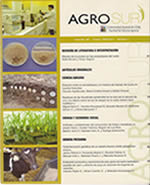Assessing phytic acid variability, using high-performance thin-layer chromatography (HPTLC), on a diverse sample of Lupinus luteus L. (Fabaceae)
Main Article Content
Abstract
Phytic acid (PA) is a main phosphorus storage source for plants and accounts for ~75% of the seed total phosphorus (P). Due to its high mineral-chelating capacity, PA has been described as an antinutritional factor in human diets and animal feed, forcing artificial Pi (inorganic phosphorus) supplementation, and increasing phosphorus pollution through animal waste. However, studies have shown positive effects for human health, with potential anticancer activity. Thus, identifying variability in PA content in plant material has become a primary target for plant breeders. The aim of this study was to asses PA seed variation in a diverse sample of L. luteus. Eighteen yellow lupin accessions were analyzed using high performance thin layer chromatography (HPTLC) to provide insights on seed PA phenotypic variation. Chromatographic profiles only detected PA and Pi in mature seeds of L. luteus accessions, suggesting that other P-containing intermediaries are not accumulated in this legume species. Analyses of variance showed significant differences for PA and Pi seed content, indicating that accumulation of these compounds was influenced, at least in part, by L. luteus genotypes. PA and Pi seed content ranged from 13.97 to 24.37 mg -1 and 1.27 to 1.68 mg g-1 (dry weight), respectively. PA significant phenotypic variation will not only aid the uncovering of possible plant metabolic pathways behind their accumulation, but also the identification of favorable variation to reduce antinutritional factors in yellow lupin.

